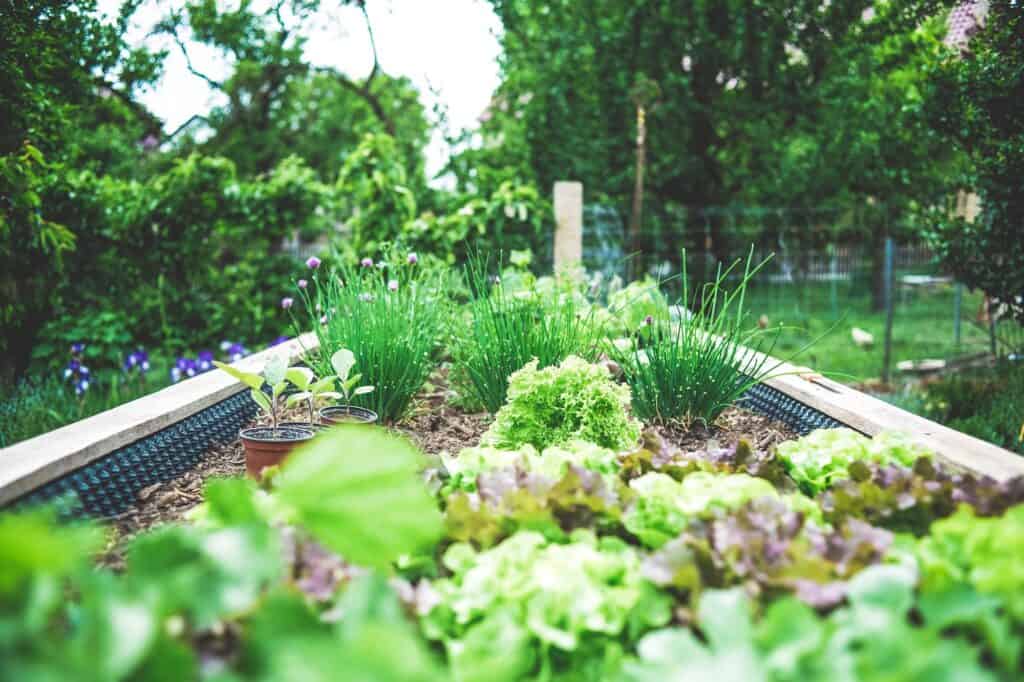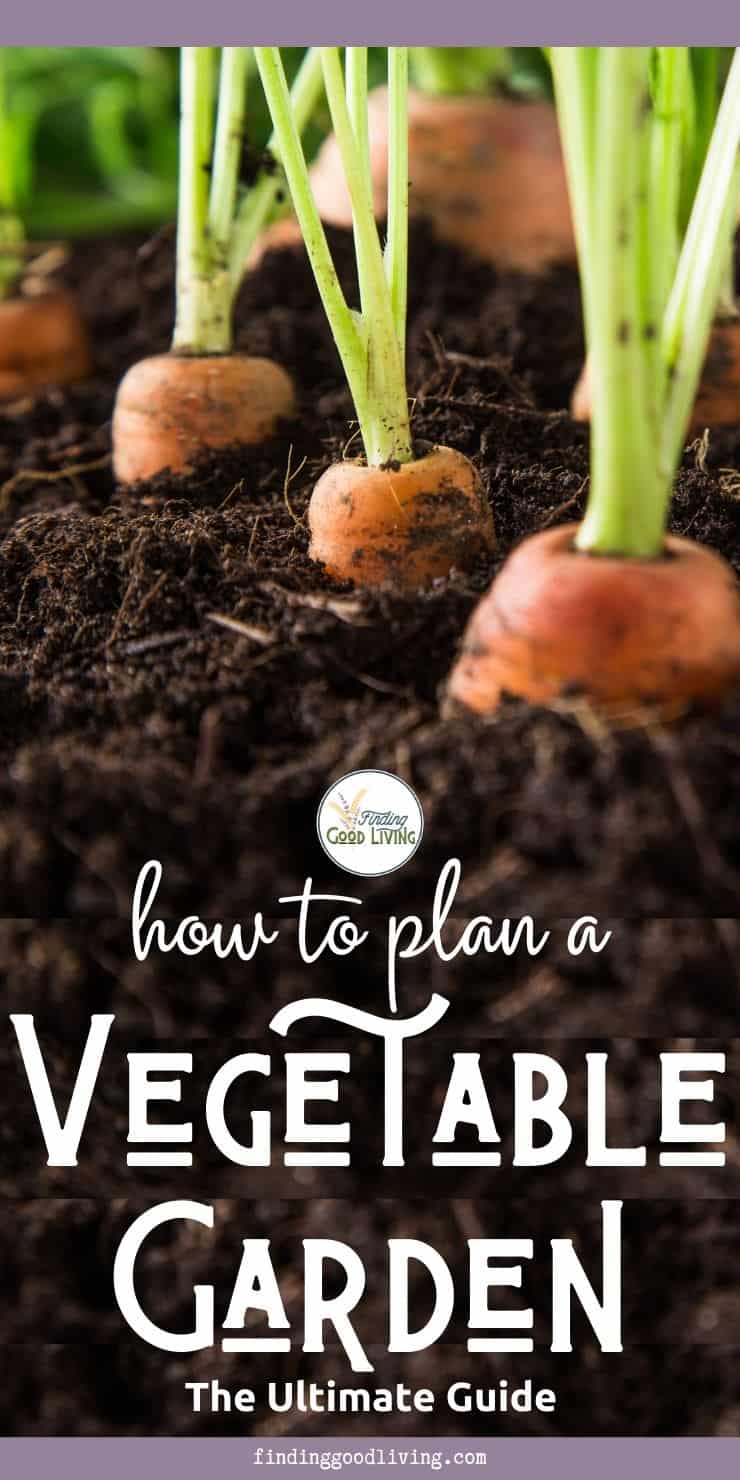This post may contain affiliate links. Please read our disclosures for more information.

Growing a vegetable garden seems to be one of those things that people either dive into headfirst or are utterly terrified to get started with.
Why is that?
There really isn’t anything scary about growing a vegetable garden, regardless of the exact format you use (container, raised beds, or large plots).
The thing that seems to hang people up, though, is not knowing how to plan a vegetable garden. Because of this, they usually seem to end up overplanted, underwhelmed, and totally lost as to how to recover things to easily grow a successful garden.
But we’re going to change all of that.
All of the information below applies regardless of whether you’re an amateur or a pro, or whether you live in a city, a neighborhood, or the country.
If you’re a brand new gardener and in need of a guide on how to start a vegetable garden from scratch, you’ll find everything you need right here. Start right at the top and read through the entire article. It may be a little overwhelming at first and seem like a lot of info to absorb, but just give it some time to process. Treat each section like an action step, if that helps, and you’ll be enjoying the fruits of your labor in no time!
If you’re a more experienced gardener that just needs a refresher on how to prepare a vegetable garden for the maximum success, then try using the table of contents button to find the topic you’re interested in diving into, and click to jump there.
Happy growing!
Table of Contents
Choosing The Best Garden Location
Assuming that you’re about to till up the lawn to put in your first garden, I want to share a word of caution:
Don’t put your garden in the most convenient spot in your yard, choose the spot that will yield the best results, whenever possible.
This is the first mistake that a lot of gardeners make — putting the garden in the wrong spot.
I’ll give you an example: in our suburban backyard, we wanted the garden all the way at the back of the lot, right against the fence, so it was butted up against where the shed was and was the most out of the way possible.
Pros: That was the lowest spot in our slightly sloped backyard, so it stayed the moistest despite hot summers AND it kept the main part of the yard wide open for kids, dogs, and family parties.
Great for keeping plants well-watered, right?
Wrong. (But you wouldn’t know that without seeing our yard.)
Cons: Directly on the other side of that fence (threatening to cross over it, in fact), to the south, is a huge tract of woods. With massive trees overhanging our yard, that meant that even at high noon in the middle of summer, the garden would be entirely in the shade. In addition, the semi-constant moisture in that spot actually increases the likelihood of various diseases and pests (like slugs).
Oh, and did I mention that our 100-foot hose didn’t reach the 120-feet or more to our preferred location?
In contrast, the BEST location for the garden in our yard was on the side of the backyard, out of the shadow of the trees where the sun wasn’t blocked more than at the very first hours of daylight, where the lawn wasn’t high and dry but wouldn’t stay underwater with a downpour, and sadly where we sort of lost some good playing space.
So what are the take-aways for choosing a good garden location?
1. Ensure ample sun exposure.
Few vegetables truly do alright in even partial shade for most of the day. Typically you’re going to want a location with a minimum of 6-8 hours of direct sunlight, but the more the merrier.
Remember, dirt + water + sunlight = happy plants, so give them what they want! Choose a location with ample sun and only very early and late shade, if possible.
The most amazing vegetable gardens, in terms of production, will have the best sun exposure.
Not everyone lives in wide-open plains, and sometimes your house and yard just simply face the wrong direction on the compass for perfect sun exposure. That’s ok, just work with it!
This isn’t a complex thing to figure out, honest! Just grab a pen and paper or a planner template and jot some notes about where the most sun falls in your yard. Try to jot a note at least three times during each day — morning, noon, and evening — watching for about a week.
2. Choose soil with good drainage.
Perhaps you’ve got a unique yard where the spot with the best sun is also essentially a pond for most of the spring and fall when the rains can be a nuisance.
This is probably NOT your best location for a garden, in most cases.
I’ll make an exception if you live in an exceptionally dry climate — putting the garden where water does naturally stay makes sense since it will help you keep your plants watered and avoid wilting.
If you’re in a more moderate climate and the moisture level is like a true pond (think visible standing water even after a hot July sun is on it all day), then this is NOT the ideal spot for a garden.
Veggie plants need enough consistent water to grow well, but they’re not aquatic plant species! Choose a location with consistent but not sopping soil moisture.
3. Place the garden for good access.
Most people won’t have a problem with actually getting to their vegetable gardens; by “good access” I mean you’re not setting yourself up for headaches later.
If you have a 100-foot long hose and put the garden 150 feet from your house, well, I hope you’ve got a good wagon or very strong arms to carry all those buckets of water.
If you don’t have a garden storage shed and your tools are in the garage, try not to put the garden as far from the garage as possible, unless you enjoy a lot of walking!
The more readily you can access tools and a water source, the more likely you are to get out and get gardening, keeping weeds under control, and ensuring plants are watered regularly.
That said, the sun and soil conditions are by far the more important factors to consider when planning a backyard vegetable garden.
Some simple solutions to these minor hiccups could be:
- Purchasing a small, easy-build shed for storing your garden tools right in or next to your garden. You’re burning enough calories by gardening, so save the time by not walking so far for forgotten tools.
- Rather than stretching an already long hose across a long distance once or twice a day for watering, you might consider adding a fixed garden spigot and a hose right at the garden — it’s easier than you think.
- OPTION 1: Simply stretch the hose across the lawn to hook up the garden watering spigot. While this allows you to easily disconnect the hose from the new spigot for use elsewhere in the lawn, the obvious hiccup is having it in the way for mowing the lawn, should it stretch across the grass and not perhaps flowerbeds only.
- OPTION 2: Bury the hose underground to avoid mowing headaches, and put a hose faucet splitter on the tap at the house to put on a second hose for general use.
4. Keep the garden easily visible from the house.
So long as you’ve prioritized sun exposure and soil moisture, try to make sure you’ve got fairly easy visibility to your garden right from inside the house.
The reason for this is purely for habit-building.
As they say, “out of sight, out of mind.” The more often you can even just look at your garden, the more likely you are to notice when you need to prune or support plants, chase away pests, or notice when some plants have a harvest ready for you.
Choosing The Right Garden Size
The very first question every new gardener asks is “how big should my garden be?”
This could be an entirely separate conversation because there are about a million factors to consider when you try to decide how big of a garden you’re going to plant.
That said, we can narrow it down to a few major points to get you thinking about what size vegetable garden to build. Here are a handful of factors to consider as you plan your vegetable garden.
1. Vegetable variety and size.
The first thing to consider when it comes to sizing a vegetable garden is exactly what you want to plant.
Different vegetables have very different spacing requirements. The space your garden needs as a whole will be directly decided based on the spacing needs of the plants you choose to grow.
The size of your garden should be ample such that you can space out all of your plants properly to allow for the best growth, but you should also plan for space to walk between and possibly around the plants if you’re building an in-ground garden.
If you’re only planting two tomato plants and two cucumber plants, for example, you’ll need a different garden size than if you only intend to grow snap peas and radishes.
Tomatoes and cucumbers, planted as stand-alone plants, need about 2-3 feet between plants (in non-vertical gardening setups), so you’d need a rough minimum of 16 square feet (think 4’ x 4’ square, for the above plant example, and they’d likely spill over your garden edges slightly at their peak size and spread. Not to mention the extra nutrition and care needed, the closer they’re planted to each other.
Peas and radishes, on the other hand, are ok with being far more snug since they are planted in rows. They can be as snug as about 3-6 inches between plants with rows about a foot apart, and you can adjust the length of the row to literally whatever you want it to be. So you could fit a far different number of plants into a 16 square foot garden.
Assuming you’re planting a fair variety of vegetables, and not just 1-2 plants or types, you’ll want to carefully consider the spacing requirements for each vegetable, and plan a fairly to-scale sketch of your garden layout. This way you can ensure each vegetable and each plant has ample space for best growth and production.
There is also one last consideration to keep in mind when sizing (ie shaping) your garden — WHAT you plant dictates what direction you should plant as well.
Always plant row crops in rows oriented north to south, when possible.
The simplest reason for this rule of thumb is that the sun travels east to west, so planting your rows along the north-south compass line ensures even sun exposure, on both sides as well as directly overhead. If you planted your rows along the east-west line, the plants in the middle of that row would really only get good overhead sun exposure, which results in leggy plants (ie. skinny, weak, etc).
2. Gardening skill level.
If you’ve got great ambitions of a half-acre first garden, then I’m over here giving you a standing ovation for your dreams, really.
But if this really is your first garden, do yourself a favor and downsize considerably.
If you’re unfamiliar with gardening, on the whole, you’ll want to start small. A 4×8 plot or raised bed may perhaps be your best bet to “get your feet wet” and have less to maintain.
The smaller the garden, the less you can grow, true, but the fewer weeds you’ll need to pull and the shorter time it will take to water your plants.
The less experience you have growing a vegetable garden, the smaller your plot should be. As your skills grow, so too can your garden patch size. Keep this proportion in mind whenever introducing new vegetable varieties into your garden — the “less is more” approach until your comfort level grows.
Choose only a few varieties of good beginner vegetables to grow in your first 2-3 years of gardening and get really good at growing those. As time goes on, you can add another 1-2 varieties each year as you feel comfortable doing so.
3. Accessibility needs and preferences.
Let’s say you’ve chosen your veggies and you’ve matched your plant quantity to your skill level, and you’ve decided you need a 12×20 garden.
Are you better off tilling the ground and prepping your vegetable garden as one large plot, or would you prefer, say, three 4×20 garden plots to work with?
There is no wrong answer to that question, by the way, so I’ll lay out a few thoughts about each option to help you decide.
OPTION 1: One large 12×20 garden plot.
Pros:
- Any tilling or compost application is done as a single task, rather than needing to repeat the process in 3 locations.
- You’ll take up less space in your yard (no need for walkways between the three beds).
- Depending on what vegetables you plant, your plantings may be more compact and you can thereby fit more into your space.
Cons:
- Depending on what vegetables you plant, your garden may not fit as much as you think, since your 12×20 space also needs to allow for you to actually access the plants and rows.
- Higher risk of trampling plants, if walk space isn’t sufficient.
- If your garden is on a slope, higher likelihood of soil erosion after a rainfall.
OPTION 2: Three smaller 4×20 beds.
Pros:
- Built-in walkway space, so you can plant some veggies closer together without the risk of trampling.
- Easier to see and reach all angles of the veggies (with 2-sided access along the 20-foot lengths), making maintenance easier. A wheelbarrow or bucket can go between rows with you while weeding, for example.
- If your garden is on a slope, less likelihood of soil erosion after a rainfall.
Cons:
- More fencing required if all 3 beds are in one fence, or possibly more walkway space needed between beds to accommodate the additional size of fencing each bed individually.
- More yard space taken up, due to adding 2-3 feet between the 3 beds as walkway space. What would be a 12×20 bed as a single plot becomes a 16×20 or 18×20 garden when split.
- Tilling or adding compost is a start-stop process rather than a single dump-and-go application.
Obviously, the split beds are the better choice for someone who is, for example, wheelchair-bound (in which case building them as raised beds would be the ideal setup).
Again, the size here is a minor difference to allow additional dedicated walk paths but could factor into how you want to arrange the garden.
(If you’re wondering, we always prefer single plot gardens with ample spacing and as compact arrangement as possible. This makes tilling or adding and raking out compost a faster chore, and it simplifies layout planning for us with fewer dimension limits on our space.)
4. Time Commitment
If you’re picturing growing a backyard vegetable garden as something you’ll plant and then not touch again until harvest, then I’m sorry to burst that bubble.
The thing that gets most newer (and even many experienced) gardeners in trouble is the time commitment. It’s TOTALLY worth it to put in the hours and the work to grow your own vegetables, but it IS another chore on the list.
You’ll get the best results if you aim to spend time daily in your garden, but as a busy family with young kids, we 100% understand that sometimes only weekly touch-time is the best you can do! Aim for a consistent 15 minutes per day, minimum, or weekly equivalent.
Do what you can, when you can. Yank the weeds from around a plant base or from a small section every time you’re in the garden, and try hard to water regularly (which you’ll want to try to fit into your early morning or close to sunset hours, by the way).
If you’re someone with plenty of free time (or not-so-free time that could easily be converted into garden time), then considering the points above having a bigger garden would be fine. If, on the other hand, you work 60 hours a week and are hardly ever home, you might consider a much smaller garden or even only container gardening.
Preparing The Soil
If you’re working on a brand new garden, you’re going to need to make a few physical changes to your soil to get the best start for your veggies.
1. Ensure the soil is loose enough to be workable.
You want the soil in your garden to be easy to dig so that planting doesn’t break your back and so roots aren’t trapped and unable to do their thing.
- Assuming you’re starting with a brand new garden, get a tiller and churn up your dirt well. A well-tilled garden will have soil that’s loose enough to shift as you walk across it.
- Regardless of a new garden or existing garden, if your soil is tilled but has large chunks (a clay-like soil), you’d do well to get a load of compost or garden soil and till that in.
Ideal soil texture is soil that crumbles fairly fine between your fingers, like a piece of cake.
*Don’t expect your soil to be perfectly textured “black gold” in your first year (or more!) of gardening. It can take a good number of years and soil amendments before the ecosystem of that patch really gets excellent. Have patience!
2. Remove weeds and keep the soil slightly moist.
You won’t do yourself any favors by growing up a nice crop of weeds just in time to need to plant your veggies.
If you aren’t planting within a day or two from when you’ve prepped your garden bed, keep an eye out for weeds so they can’t get a strong foothold, and keep the soil slightly moist to maintain good workability.
You’d be surprised how fast weeds can take over, especially if you get a rainy day or two between prepping and planting.
If the soil is dry and cracked by the day you’re planting, you’ll have a hard time digging holes. If you hose it down right before planting, you’ll likely end up dealing with mud instead of dirt.
3. Check soil chemistry if needed.
Most of the time, dirt is dirt. You put a plant in the ground, you water it, you get veggies in a little while. I will say that personally, living in the Northeast US, we have NEVER had the soil tested, and yet we have pretty much ALWAYS had sufficient production and harvest.
That said, I’ll acknowledge that we’ve put plenty of excellent compost into our garden, done a lot of watering and a mediocre level of fertilizing through the seasons, so it’s entirely possible that we’ve just self-corrected poor soil.
Keep in mind that regardless of soil chemistry, it IS possible to improve your soil quality and production over time, without chemistry-driven soil amendments.
This soil preparation step one is for the more advanced gardeners, because since dirt is typically dirt — and “works” just fine — you’re honestly probably going to need at least a few years before you notice if your soil truly does have a chemistry issue.
If after a couple of years, you’re struggling hard with weeds, diseases, and poor growth/production — we’re talking doing everything right but still having discolored, wilting, or straight-up dead plants — then you’ll want to test the soil to see if that’s a factor (of course assuming pests are ruled out).
It’s a good idea to test your soil in the spring, before planting of course, so that you aren’t testing soil right after the growing season ends and nutrients may be somewhat depleted. Let the soil “rest” a little while, like over the winter, and test in spring so you get a better picture.
Here are some great options for soil testing methods:
- Rapitest Soil Test Kit — This is a great starting point for a quick test, just to get some insight into where your soil falls. From there you’ll have to dig in a little to see exactly what to do with those results, in terms of any amendments needed.
- LaMotte Garden Kit — A more comprehensive kit than the one above, this also includes a couple of guides to educate you on garden soil chemistry and also offers specific actions that correspond to the test results.
- For a reasonable small fee, you can actually send a soil sample to your local extension office if you wanted a more professionally done soil test. This is something that large-scale growers and farmers will do more often than a typical homeowner. That said, they can provide more info than simply nutrient and pH levels — they can advise on soil amendments, pest concerns, frost dates, water quality, and more. You can find your local extension office, by choosing your state through that link.
Protect Your Garden
It should go without saying that there is utterly no point in spending all the time and effort of planting a garden if you’re going to let it get destroyed by nature, typically in the form of critters and pests.
1. Install a fence around your garden.
The first and most obvious method of safeguarding your garden is to build a garden fence.
If it’s your very first garden and you might want to move it in the yard next year…you’ll probably still want a fence.
If your garden is in a fully fenced backyard but you’ve got kids or a dog…you’ll probably still want a fence.
If you’re choosing to make your garden with raised beds this year…you’ll probably still want a fence.
If you live in a city with a very small backyard AND your backyard is fenced AND you have no kids and no dog…well, you’re probably good without it.
Ok, so I’m belaboring the point. But there’s a reason.
DURING YOUR PLANNING is the BEST time to consider the fencing options, and BEFORE you put the plants in the garden is the ideal time to put the fence in.
The last thing you want to do is ruin your plants during a fence installation mishap. You also might use the fencing in your garden layout decisions, like if you’re going to train your peas or cucumbers to climb the fence to maximize space.
2. Consider frost protections.
If you’re going to be attempting to stretch your growing season and plant early or harvest later, you’ll need to consider frost protection options for the outer ends of the season.
By that, I mean things like row covers, cold frames, greenhouses, etc.
Row covers can be in two forms:
- Clear or semi-opaque plastic row covers over arches or breathable fabric floating row covers laid directly on plants. Both of these will help provide both frost and decent pest protection, but you’ll want to consider your needs carefully to choose between the types. The plastic will retain heat and moisture, whereas the fabric provides better venting, but thereby less heat and moisture retention.
- Black plastic laid directly on the soil, to heat the roots of the plants but allow growth. This would be laid on the soil and holes added at even spacing to allow your plants to grow through, planted either at seed or seedling stage, so make sure the hole is large enough to accommodate the adult plant! This method DOES make watering a little bit more of a chore, since the plastic is not permeable.
Cold frames and greenhouses are both generally semi-permanent or permanent structures. These are worth considering during your garden planning, even as a beginner, because you’ll likely want your greenhouse either close to the house or close to the garden, which may affect your layout sizing and shape.
If you’re looking to build your own, here’s a great book on building and using cold frames.
You can also purchase a ready-made cold frame or a ready-made greenhouse, if you’re not so handy or simply don’t have the time to build your own.
*For a greenhouse in your garden, keep in mind that any greenhouse kits you may purchase with metal poles and a plastic zip cover likely should not be left standing all year round. A solid, aluminum frame greenhouse is far more durable and can be built as a garden feature that stands year round. DO remember to check with your town for any possible permit requirements before building your fixed greenhouse, home-made or otherwise.
If all of those options above are overwhelming, I’ll let you in on a little secret: even something as simple as a 5-gallon bucket with the bottom cut out will make a decent frost protection for newly planted tomato plants and other standalone veggies. A roll of clear plastic, gently draped over the ground and anchored with landscape fabric stakes, will do the job to “greenhouse” your rows and force seeds to start without a lot of setup required.
Plan A Vegetable Garden Layout
I honestly think this is THE HARDEST part of planning a garden every year.
After a year or two, you’ll have your location, size, variety, etc. pretty much sorted out.
But every year without fail, we find ourselves struggling to fit everything into our garden.
(Our problem ultimately boils down to our planting dreams outsizing our available space, but that’s a different story.)
We may have started a few too many tomato seeds, and it’s just too hard to toss the extra plants into the compost pile.
Maybe we just totally disregarded garden size, got a little carried away, and kept adding pepper varieties (it’s never good enough to have just ONE type of hot pepper – we always find ourselves growing both old favorites and new discoveries)!
Or we declared that “this is the year” we were going to grow enough rows of peas, beans, carrots, cabbages, and radishes to store up for the winter like Rabbit from Winnie the Pooh.
(We lack his seriously hardcore dedication, however.)
So what’s an overly ambitious gardener to do?
I hope you paid attention in middle school math because it’s come a-callin for you.
Method 1: The Middle School Math Problem
“If I have 90 square feet of gardening space, and I want to plant 10 varieties of vegetables with equal portions in the garden, then I have 9 square feet per variety and that means I can fit how many of each vegetable?”
It doesn’t matter if you want equal portions like the silly example problem above, or if you want only one plant of three of your varieties and you fill up the rest however you can.
Do some rough calculations with some rectangles on a scratch paper, and figure out how much space you’re *supposed* to have for the number/variety of plants you’re hoping to grow, and then fiddle those numbers here and there, wheedling the size up or down until it all fits.
It’s a little cumbersome, but it’s quick and dirty and will get the job done for a fair ballpark plan.
Honestly, if you want to wing it you can stop here and trust that it will all fit.
When it comes to planting time, you can choose to keep plants grouped together or even mixed up some if you like, just keep an eye on your neighboring plants for companion planting reasons and optimum growth.
Method 2: The Graphing Wizard
There are two ways to approach this method — I’ll call one “forwards” and one “in reverse.”
If you’re planning your garden layout “forwards,” then you’re actually going to do Method 1 and get some base numbers to work off of first.
Once you know how many square feet of, for example, tomatoes you want to grow, grab a graph paper, draw the to-scale outline of your garden, and then sketch out the size/shape of the space within the garden for where the tomatoes will go.
You can plant in a rectangle, square, triangle, circle, or just a row or two — it’s up to you to decide what fits where, as you add in your other vegetable varieties to design your backyard garden layout.
If, however, you’d rather plan your garden “in reverse,” you’re going to start with the graph paper and work your way backward to the numbers.
By that, I mean that you’ll start with your to-scale outline of your garden on graph paper. From there, decide how much of your garden will be for tomatoes, cucumbers, peas, etc, until you’ve portioned out all the varieties you’re planning on.
Since your sketch is to-scale, count the squares and do some simple calculations to determine the area available per variety. Work backward to the next level by dividing the available area for one vegetable by the area required for a single plant of that variety. This will give you the number of plants that will fit.
You can probably see that doing your figuring in either direction has its merits.
Generally, I would advise calculating things forwards if you have no clue how many plants of each you’d like to put in, so that you work with actual numbers of plants and can decide if, for example, 10 tomato plants are too many or too few. You can then tweak other veggies as needed to make the room as needed.
This is also a great method to let you see the number of plants that fit per variety so that if you planted 10 plants last year and already know you want more planted this year, you can quickly see how much square footage you’d need to expand your garden by
In contrast, if you’ve been gardening in the same plot for a long time and you’re just in need of remembering the number of seedlings to start, you can ballpark the rough proportions of how you usually plant via the “in reverse” option, and back-calculate from there.
Method 3: The “Type A” Spreadsheet Master
This is me. 100%, unashamedly, yes-it’s-a-problem-and-I’m-totally-okay-with-that.
This is the method where you go full-digital, and you use a spreadsheet and hard-coded data to make utterly zero mistakes in your planning. By the time you’re done, you’ve got a literal map of where EVERY SINGLE PLANT goes within your garden.
Sounds awesome?
It is.
Keep an eye out as we work to finish building this spreadsheet for you!
We’re building a spreadsheet that DOES help you build a literal vegetable garden layout planting map so you can build the ultimate vegetable garden layout, whether you need a small garden layout, a raised bed garden layout, or a large-scale backyard garden layout.
If you want to be one of the first to get your hands on this product, sign up for the waitlist below.
Advanced Garden Planning Considerations
For those of you who are several years into your gardening adventures or are large-scale/farm gardeners, you’ll want to consider these other few factors as you get into gear for the season:
Water Quality
If you’re using city water, you’re probably just fine in terms of pH balance, risk of contaminants, etc. You may find, however, that the common chlorination and fluoride treatment of city water affects your plants — these are not nutrients that plants need in high amounts in their water, after all!
Should you be using well water, ask yourself when the water was last tested. You might find yourself with slightly sulfuric water (which you should be able to smell as it becomes a problem!), which will affect how well your plants grow and produce. If you’ve got a bacterial infiltration that you’re unaware of, you run the risk of those tiny bacterial cells being taken up by some of the plants and causing illnesses once the crop is ingested.
If you’re using rainwater, you may still have been collecting acid rain that you can’t avoid, or contaminants from your roofing material if you’re using gutter-filled rain barrels. Although whatever rain fell also landed on your plants and is probably just fine, consider treating the water if your plants seem to be doing poorly and other factors are not at play.
Succession Planting
Not every vegetable can be grown with succession planting in mind, but probably many more than you think can be.
Succession planting is simply planting the same vegetable in succession, as opposed to all at once.
The most common veggies in the average backyard vegetable garden that can easily apply this planting method are the shortest days-to-harvest veggies, such as:
- Peas (60-70 days to harvest)
- Beans (50-60 days to harvest))
- Carrots (60-80 days to harvest))
- Radishes (roughly 21 days to harvest for most types)
- Lettuce (45-55 days to harvest))
- Spinach (35-45 days to harvest))
Even in our northeastern climate where the growing season is really only about 4 months long, with minimal effort, we can get 2-4 successive harvests in with careful planning.
But some other vegetables which can take advantage of succession planting are:
- Cucumbers (50-70 days to harvest)
- Zucchini (40-60 days to harvest)
- Potatoes (70-80 days to harvest)
- Tomatoes (90-140 days to harvest)
For as long as I can remember, my grandfather would always start the second round of cucumber seeds around the fourth of July, about a month (give or take) after his garden was first planted for the season, and he would repeat along the row at the beginning of August as well. I can’t remember a day at his house in the summers, no matter when we went, when there wasn’t fresh, ripe, ready-to-pick cucumbers hanging somewhere off those plants!
My point is, while it takes some solid knowledge and careful planning to effectively spread the harvest out across the season by way of succession planting, there is no reason it can’t be done with more veggies than you’d think. Our gardening season typically is done and over by the end of September, but with diligent work in the garden and good weather we’ve still been harvesting tomatoes by Halloween some years.
(The other fun fact about tomatoes, in particular, is that if you grow tomatoes of an indeterminate variety, it is 100% possible to start a new plant from a branch, bring your reasonable-sized plant inside, and continue to propagate and grow tomatoes even outside the normal growing season. You may have to be really on top of pruning and its needs and also get creative with pollination, but the plant will cooperate in an ideal setup!)
If succession planting sounds like something you’re interested in, you might want to grab a free copy of our succession planting reference chart. If you’re on our email list (or joined the waitlist above), you’ll have an email with access info for our library of free gardening resources.
This will help you determine what to plant and when to keep you on top of things!
Companion Planting
In my humble opinion, this is the coolest part of gardening.
You can get as fancy as planting your veggies next to their preferred veggie neighbors, or you can be as relaxed as simply choosing the right flowers to plant around the outside of your garden!
Companion planting means being conscientious about what plants neighbor each other, to avoid nutrient competition, attract pollinators, and overall increase production.
Again, the depth to which you apply this technique is up to you.
Perhaps you want to be particular about companion plants for tomatoes, so you’re going to surround them with carrots, cucumbers, and garlic when you plant your garden.
Or maybe you’re going to just toss a few marigolds just outside the garden fence from your tomato plants, and call it good (and pretty).
There really is, I think, an art to planning your garden planting around companion planting principles, so remember these silly sayings when planning your planting groupings:
- Grow your salad together. (Tomatoes, cucumbers, and lettuce can be companions.)
- If it grows in rows, it’s good to go. (With the exception of garlic and onions, most all row-grown vegetables can be near each other — carrots, peas, beans, radishes, etc.)
- Spinach and spice and everything nice. (Garlic as a “spice”, and it’s close cousin onions are fine to grow near your spinach rows. They can also go near your salads, since they’re a common salad topper, after all!)
- Broccoli and blooms. (Marigolds near broccoli will grow quite well. Marigolds are also a great companion for your salad veggies, to attract pollinators!)
Final Thoughts On How To Plan A Vegetable Garden
If you’ve made it this far into the article, you clearly have the dedication and drive required to become an epic gardener, if you aren’t one already.
No matter where you are along your gardening (or even homesteading) journey, learning how to plan a garden is an important part of your success.
As you’ve seen above, there are a lot of factors to consider for a truly micromanaged vegetable garden layout or plan, but at the same time, remember this: start some seeds or buy some plants, stick them in the ground, and water them. With literally no planning involved, you’ll still surely get at least some vegetables to harvest and enjoy from them.
(If you need any one-on-one help or advice on how to get your garden planned out and prepped, either send us an email or ask in our private homesteaders’ Facebook group, Finding Good Living.)
STAY IN THE LOOP








Leave a Reply